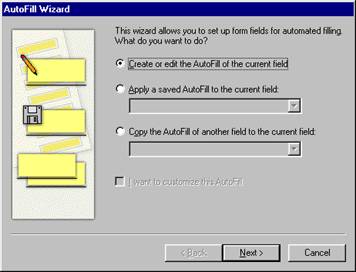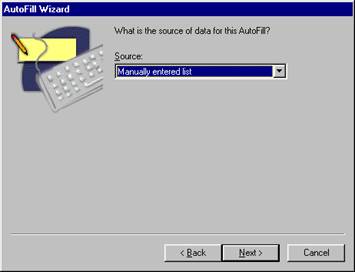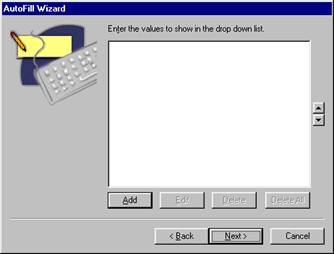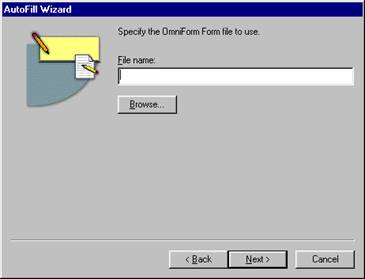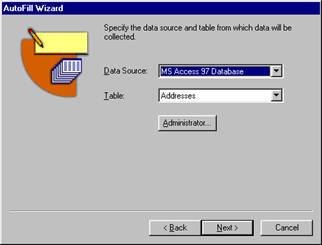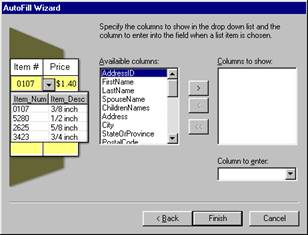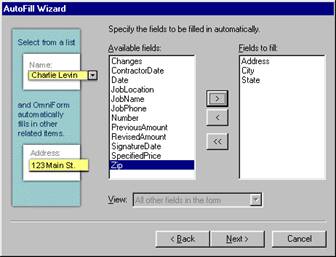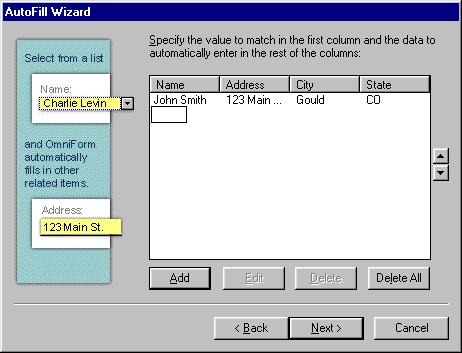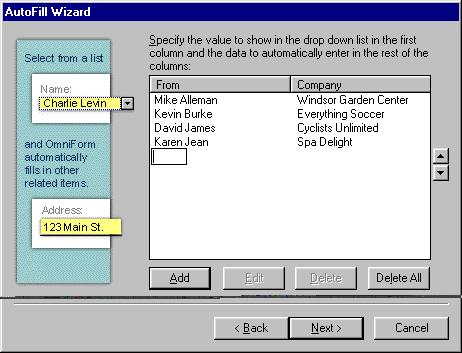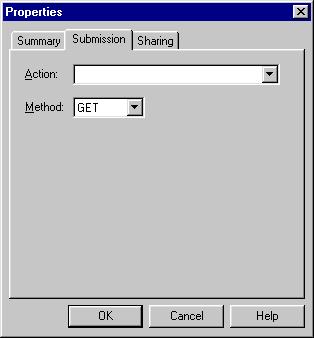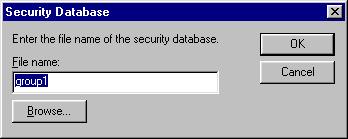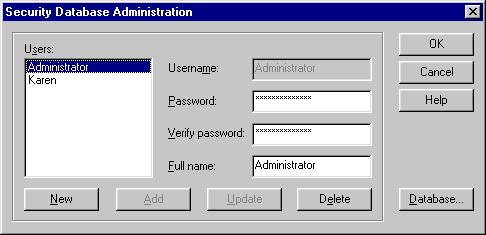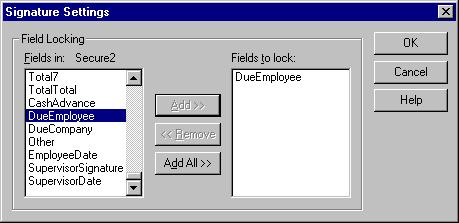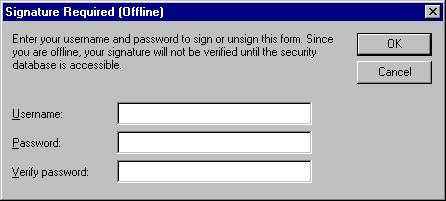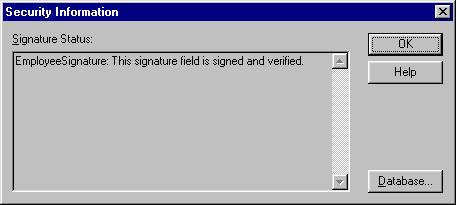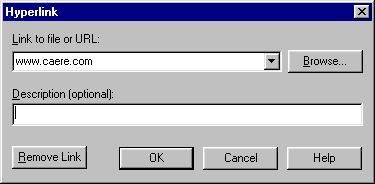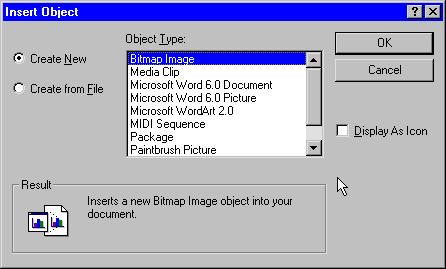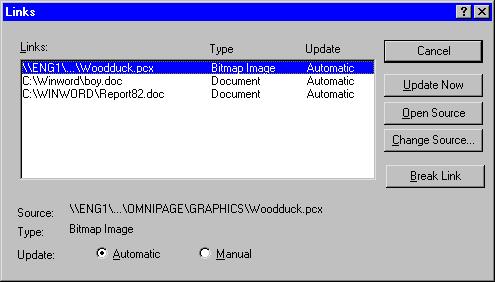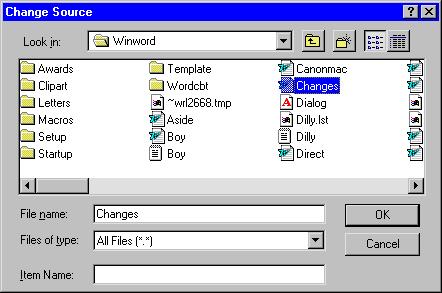Table of Contents
Advanced Features
This chapter discusses how to use some of the advanced features in iDocs. Although these are advanced features they are not hard to learn. After you have become familiar with some of the basic form design options in iDocs, try some of these features. These features can really enhance the design of your forms. For a description of iDocs’s basic design features, see “Designing a Form.”
This chapter contains the following sections:
- Setting up a Form for Automated Data Entry
- Setting Attributes for a Form
- Adding Security to Your Forms
- Adding Hyperlinks to Your Forms
- Using the Scrapbook
- Inserting OLE Objects in a Form
The flashFORM\Sample Forms folder contains several sample forms that you can use or redesign for your needs.
Setting up a Form for Automated Data Entry
Using the AutoFill Wizard, you can set up a form for automated data entry. You can create or use an AutoFill list to provide a drop-down list of possible entries for the person who fills in a form or to provide an automatic filling of specific fields on a form. You can create a new AutoFill list, use a list from another field, use a previously defined list, create a list from an ODBC source, or create a list from a iDocs form or database.
This section describes how to:
- create a new AutoFill list
- create an AutoFill from another source
- automatically fill fields on a form
- create an AutoFill list and automatically fill fields
- create an AutoFill list and/or automatically fill fields in a table
- create a replacement list
Before you begin using the AutoFill Wizard, please read all the sections of “Setting up a Form for Automated Data Entry” to get an idea of how the Wizard works and to become familiar with some of the Wizard’s dialog boxes.
Creating a New AutoFill List
This section explains how to create a new AutoFill list. By creating a new AutoFill list, you create a drop-down list of choices for the person who fills in the form, including the information for this new list.
To create a new AutoFill list:
- Open a form and select a field (either Fill Text or Comb objects) where you want to create a drop-down list.
- Choose Object Definition… in the Format menu.
The Fill Text Definition dialog box appears. - Click the Filling tab in the Fill Text Definition dialog box.
- Select Enable AutoFill and click AutoFill Wizard….
The following AutoFill Wizard dialog box appears.
- Select Create or edit the AutoFill of the current field to create a list for your selected field and click Next>.
The following dialog box appears.
- Select Show a list of choices and click Next>.
The following dialog box appears.
- Select Manually entered list to create the information for your AutoFill list and click Next>.
The following dialog box appears.
- Click Add and type the information that you want to include in your list in the provided text box. Each item in a column can have a maximum of 100 characters.
After each entry, press Enter. Continue adding information to your list and, when you are finished, click Next>. - Select whether you want to save your list in the dialog box that appears. If you are saving your list, type a name.
iDocs saves your list as a .txt file. - Click Finish to close the AutoFill Wizard and, if selected, to save your list.
The Fill Text Definition dialog appears. - Click OK to apply your settings and close the dialog box.
Create or Use an AutoFill List From Another Source
You can create or use an AutoFill list from a variety of sources, such as a previously saved AutoFill list, an AutoFill list from another field, an AutoFill list from an ODBC source, and an AutoFill list from a iDocs Form or Database.
Use a Previously Saved AutoFill List
You can use a previously saved AutoFill list and apply it to your current field. This can save you time if you have already created a list that could be used again. For example, you may have created a list containing the names of all your customers and would like to use that information for your current field.
To use a previously saved AutoFill list:
- Open a form and select a field where you want to use another AutoFill list.
- Choose Object Definition… in the Format menu.
The Fill Text Definition dialog box appears. - Click the Filling tab in the Fill Text Definition dialog box.
- Select Enable AutoFill and click AutoFill Wizard….
- Select Apply a saved AutoFill to the current field.
- Select the AutoFill list that you want to use for your form from the drop-down list.
- If you are not customizing your list, you are finished. Click Finish to close the Wizard, and OK to apply your settings and close the dialog box.
- If you want to customize or make changes to your list, select I want to customize this AutoFill check box and click Next>.
- Select Show a list of choices in the next dialog box to display your list and make your changes. Each item in a column can have a maximum of 100 characters.
- To add an entry to the list, click Add and type the new entry in the provided text box.
- To make a change to the list, select the entry and then click Edit. Type your changes in the provided text box.
- To remove an entry, select the entry and then click Delete.
- To remove all entries from the list, click Delete All.
Click Next> when you are finished customizing the list.
- Select whether you want to save your list. If you are saving your list, type a name. iDocs saves your list as a .txt file.
- Click Finish to close the AutoFill Wizard and, if selected, to save your list.
The Fill Text Definition dialog box appears. - Click OK to apply your settings and close the dialog box.
Use an AutoFill List From Another Field
You can use an AutoFill list from another field and apply it to your current field. For example, you may have created an AutoFill field (for example, a State field) for all 50 states and would like to use that field’s list and apply it to your current field.
To use an AutoFill list from another field:
- Open a form and select a field where you want to use an AutoFill list from another field.
- Choose Object Definition… in the Format menu.
The Fill Text Definition dialog box appears. - Click the Filling tab in the Fill Text Definition dialog box.
- Select Enable AutoFill and click AutoFill Wizard….
- Select Copy the AutoFill of another field to the current field.
- Select the AutoFill list that you want to use in the drop-down list.
- If you are not customizing your list, you are finished. Click Finish to close the Wizard, and OK to apply your settings and close the dialog box.
- If you want to customize or make changes to your list, select I want to customize this AutoFill check box and click Next>.
- Make any changes to your list in the dialog box that appears. Each item in a column can have a maximum of 100 characters.
- To add an entry to the list, click Add and type the new entry in the provided text box.
- To make a change to the list, select the entry and then click Edit. Type your changes in the provided text box.
- To remove an entry, select the entry and then click Delete.
- To remove all entries from the list, click Delete All.
Click Next> when you are finished customizing the list.
- Select whether you want to save your list. If you are saving your list, type a name. iDocs saves your list as a .txt file.
- Click Finish to close the AutoFill Wizard and, if selected, to save your list.
The Fill Text Definition dialog box appears. - Click OK to apply your settings and close the dialog box.
Create an AutoFill List From a iDocs Form or Database
You can create an AutoFill list from a iDocs form or database for your current field. For example, you may have a iDocs database containing all Zip codes. You can use that information as an automatic data entry for your current field.
To create an AutoFill list from a iDocs form or database:
- Open a form and select a field where you want to use the information from another form or database.
- Choose Object Definition… in the Format menu.
The Fill Text Definition dialog box appears. - Click the Filling tab in the Fill Text Definition dialog box.
- Select Enable AutoFill and click AutoFill Wizard….
- Select Create or edit the AutoFill of the current field and click Next>.
- Select Show a list of choices and click Next>.
- Select the type of source you want to use.
Each item in a column can have a maximum of 2000 characters.- Select iDocs Form to use information from another iDocs form.
- Select iDocs Database to use information from a iDocs database, that is, a file with an .ofd extension.
- Click Next>.
The following dialog box appears if you have selected iDocs Form.
- Type the file name of the iDocs form (or iDocs database) you will be using in the File name text box.
Or, click Browse… to locate your file.- Locate and select a file.
- Click OK to return to the AutoFill Wizard dialog box.
The name of the selected file appears in the File name text box.
- Click Next>.
- Specify the columns (or fields) that you want to use in your drop-down list.
Also, select the field that you want to appear first in your drop- down list. You can have a maximum of 10 columns displayed in your drop-down list.- Select the columns in the Available columns list and click the right- arrow button. The columns you have chosen appear in the Columns to show list box. All the columns you choose will appear in the drop- down list. This is useful if you want more information to appear in the drop-down list.
- In the Columns to enter text box, choose the field you want to appear first in the drop-down list. The information you choose from this column is what appears first in the field in fill view.
- Click Finish to close the AutoFill Wizard.
The Fill Text Definition dialog box appears. - Click OK to apply your settings and close the dialog box.
Create an AutoFill List From an ODBC Source
You can create an AutoFill list from an ODBC source and use the information for your current field.
To create an AutoFill list from an ODBC source:
- Open a form and select a field where you want to create on AutoFill list using information from an ODBC source.
- Choose Object Definition… in the Format menu.
The Fill Text Definition dialog box appears. - Click the Filling tab in the Fill Text definition dialog box.
- Select Enable AutoFill and click AutoFill Wizard….
- Select Create or edit the AutoFill of the current field and click Next>.
- Select Show a list of choices and click Next>.
- Select ODBC Database to use information from a database (such as, dBASE or Microsoft Access) and click Next>.
Each item in a column can have a maximum of 2000 characters. - Specify the data source and table in the following dialog box.
If you have not set up your data source previously, click Administrator… and follow all the dialog boxes for your specific database. For more information about these dialog boxes, please see your specific database documentation.
- Select the data source you will be using from the Data Source drop- down list.
- Select a Table you would like to use from the Table drop-down list.
- Click Next>.
A dialog box similar to the one below appears.
- Specify the columns (or fields) that you want to use in the drop-down list. Also, select the field that you want to appear first in the drop-down list. You can have a maximum of 10 columns displayed in your drop- down list.
- Select the columns in the Available columns list and click the right- arrow button. The columns you have chosen appear in the Columns to show list box. All the columns you choose will appear in the drop- down list.
- In the Columns to enter text box, choose the field you want to appear first in the drop-down list. The information you choose from this column is what appears first in the field in fill view.
- Click Finish to close the AutoFill Wizard.
The Fill Text Definition dialog box appears. - Click OK to apply your settings and close the dialog box.
Automatically Fill Fields on a Form
You can automatically fill fields on your form with AutoFill lists from a variety of sources. You can fill fields automatically using lists you create, or information from ODBC sources, iDocs forms or databases.
This section describes how to create an automatic filling for your form. You create an automatic filling by allowing specific fields to be filled automatically after a certain field has been filled. For example, your form may have Name, Address, City, State, and Zip fields. In this case, you might want to set up the form so that once the Name field has been filled, the Address, City, State, and Zip fields will be filled automatically.
Automatically Fill Fields on a Form With an AutoFill List You Create
You can have fields on your form automatically filled with an AutoFill list you create. First specify a field so that once that field is filled other fields will be automatically filled. Next, create an AutoFill list. Finally, specify the fields on the form that you want automatically filled and then define the information that will be automatically filled in each field.
To automatically fill fields on a form with an AutoFill list you create:
- Open a form and select a field where you want to create an automatic filling using an AutoFill list.
- Choose Object Definition… in the Format menu.
The Fill Text Definition dialog box appears. - Click the Filling tab in the Fill Text Definition dialog box.
- Select Enable AutoFill and click AutoFill Wizard….
- Select Create or edit the AutoFill of the current field and click Next>.
- Select Fill other fields automatically after the field is filled to create an automatic filling for your form, and click Next>.
- Select Manually entered list to use an AutoFill list for your form, and click Next>.
A dialog box similar to the one below appears.
- Specify the fields that you want to be filled automatically.
- Select the fields in the Available fields list and click the right-arrow button. The fields you choose appear in the Fields to fill list. The Available Fields list displays all the fields on your form.
The Fields to fill list displays all the fields on the form that you want filled automatically. - To remove the fields from the Fields to fill list, select the fields from the Fields to fill list and then click the left-arrow button.
The fields you have chosen return to the Available fields list.
- Click Next>.
A dialog box similar to the one below appears.
- Type the entries that you want in the columns. The first column, the Name field is the selected field on your current form. Once the Name field (or John Smith) is filled, the other fields on the form, that is, Address (or in this case, 123 Main St.), City (that is, Gould), and State (that is, CO) fields, will be filled automatically.
Click Next> when you are finished. - Click Finish to close the AutoFill Wizard.
The Fill Text Definition dialog box appears. - Click OK to apply the settings and close the dialog box.
Automatically Fill Fields on a Form With a iDocs Form or Database
You can have fields on your form automatically filled with information from a iDocs form or database. First, specify the field so that once it is filled other fields on the form will be automatically filled. Next, select the iDocs form or database that you want to use. Finally, specify the fields on the form that you want automatically filled and then define the information that will be automatically filled in each field.
To automatically fill fields on a form with information from a iDocs Form or Database:
- Open a form and select a field where you want to create an automatic filling using a iDocs form or database.
- Choose Object Definition… in the Format menu.
The Fill Text Definition dialog box appears. - Click the Filling tab in the Fill Text Definition dialog box.
- Select Enable AutoFill and click AutoFill Wizard….
- Select Create or edit the AutoFill of the current field and click Next>.
- Select Fill other fields automatically after the field is filled to create an automatic filling for your form and click Next>.
- Select the iDocs form or database that you want to use. Each item in a column can have a maximum of 2000 characters.
- Select iDocs Form to use information from another iDocs Form and click Next>.
- Select iDocs Database to use information from another iDocs database (that is, a file with an .ofd extension) and click Next>.
- Type the file name of the iDocs form or database you will be using in the File name text box.
Or, click Browse… to locate your file.- Locate and select a file.
- Click OK to return to the AutoFill Wizard dialog box.
- The name of the selected file appears in the File name text box.
- Click Next>.
- Select, in the Column/field drop-down list, the column (or field) from your database that you want to match against the data in the current selected field on your form.
Click Next> when you are finished matching the data with the field on your form. - Specify the fields that you want filled automatically.
- Select the fields in the Available fields list and click the right-arrow button. The fields you have chosen appear in the Fields to fill list. The Available Fields list displays all the fields on your form. The Fields to fill list displays all the fields on the form that you want filled automatically.
- To remove the fields from the Fields to fill list, select the fields from the Fields to fill list and then click the left-arrow button. The fields you have chosen return to the Available fields list.
Click Next> when you are finished specifying the fields you want automatically filled.
- Specify the links between the fields to be automatically filled in the form and the columns in the database. By linking the fields to the columns, you tell iDocs what database information needs to be placed in what field on your form.
- Select an entry from Fields in form and then an entry in Columns in database. Click «Link». Your selection appears in the Links box.
- You can let iDocs automatically link fields with columns. Click «Auto». iDocs automatically matches fields with columns of the same name and displays the linkage in the Links box.
- To remove an entry from the Links box, select the entry that you want and click Unlink. If you want to remove all entries in the Links box, click Unlink All.
- Click Finish to close the AutoFill Wizard.
The Fill Text Definition dialog box appears. - Click OK to apply your settings and close the dialog box.
Automatically Fill Fields on a Form With an ODBC Source
You can have fields on your form automatically filled with information from an ODBC source. First specify a field so that once it is filled other fields will be automatically filled. Next, select the ODBC source that you want to use. Finally, specify the fields on the form that you want automatically filled and then define the information that will be automatically filled in each field.
To automatically fill fields on a form with information from an ODBC source:
- Open a form and select a field where you want to create an automatic filling using information from an ODBC source.
- Choose Object Definition… in the Format menu.
The Fill Text Definition dialog box appears. - Click the Filling tab in the Fill Text Definition dialog box.
- Select Enable AutoFill and click AutoFill Wizard….
- Select Create or edit the AutoFill of the current field and click Next>.
- Select Fill other fields automatically after the field is filled to create an automatic filling for your form and click Next>.
- Select ODBC Database to use information from a database (such as dBASE or Microsoft Access) and click Next>.
Each item in a column can have a maximum of 2000 characters. - Specify the data source and table.
- Select the source of your data from the Data Source drop-down list.
- Select the table from the Table drop-down list.
If you have not set up your data source previously, click Administrator… and follow all the dialog boxes for your specific database. For more information about these dialog boxes, please see your specific database documentation.
- Click Next>.
A dialog box similar to the one below appears.
- In the Column/field drop-down list, select the column (or field) from your database that you want to match against the data in the current selected field on your form.
Click Next> when you are finished matching the data with the field on your form. - Specify the fields that you want filled automatically.
- Select the fields in the Available fields list and click the right-arrow button. The fields you have chosen appear in the Fields to fill list. The Available Fields list displays all the fields on your form. The Fields to fill list displays all the fields on the form that you want filled automatically.
- To remove fields from the Fields to fill list, select the fields from the Fields to fill list and then click the left-arrow button. The fields you have chosen return to the Available fields list.
- Click Next> when you are finished specifying the fields you want automatically filled.
A dialog box similar to the one below appears
- Specify the links between the fields to be automatically filled in the form and the columns in the database. By linking the fields to the columns, you tell iDocs what database information needs to be placed in what field on your form.
- Select an entry from the Fields in form and then an entry in Columns in database. Click «Link». Your selection appears in the Links box.
- You can let iDocs automatically link fields with columns. Click «Auto». iDocs automatically matches fields with columns of the same name and displays the linkage in the Links box.
- To remove an entry in the Links box, select the entry that you want and click Unlink. If you want to remove all entries in the Links box, click Unlink All.
- Click Finish to close the AutoFill Wizard.
The Fill Text Definition dialog box appears. - Click OK to apply your settings and close the dialog box.
Creating an AutoFill List and Automatically Fill Fields
You can create both an AutoFill list and have fields automatically filled for your form. You can automatically fill fields by using a list you create, information from an ODBC source, iDocs form, or database. The AutoFill Wizard can easily do both.
To create an AutoFill List and automatically fill fields:
- Open a form and select a field where you want to create an AutoFill list and automatically fill fields.
- Choose Object Definition… in the Format menu.
The Fill Text Definition dialog box appears. - Click the Filling tab in the Fill Text Definition dialog box.
- Select Enable AutoFill and click AutoFill Wizard….
- Select Create or edit the AutoFill of the current field and click Next>.
- Select Show a list of choices and automatically fill other fields in the dialog box that appears and click Next>.
- Select Manually entered list to use information created with the AutoFill Wizard and click Next>.
- Specify the fields that you want to be filled automatically.
- Select the fields in the Available fields list and click the right- arrow button. The fields you have chosen appear in the Fields to fill list. The Available Fields list displays all the fields on your form. The Fields to fill list displays all the fields on the form that you want filled automatically.
- To remove the fields from the Fields to fill list, select the fields from the Fields to fill list and then click the left-arrow button. The fields you have chosen return to the Available fields list.
- Click Next>.
A dialog box similar to the one below appears.
- Type the entries in the appropriate columns. For example, the first column in this dialog box, the Company field, is the selected field on your current form; that is, the field that contains the drop-down list. The second column, the From field, is the field that will be automatically filled once the Company field is filled.
- Click Next>.
- Select whether you want to save your list. If you are saving your list, type a name.
- Click Finish to close the AutoFill Wizard.
The Fill Text Definition dialog box appears. - Click OK to apply the settings and close the dialog box.
To create an AutoFill list and automatically fill fields with an ODBC source:
- Open a form and select a field where you want to create an AutoFill list and automatically fill fields using information from an ODBC source.
- Choose Object Definition… in the Format menu.
The Fill Text Definition dialog box appears. - Click the Filling tab in the Fill Text Definition dialog box.
- Select Enable AutoFill and click AutoFill Wizard….
- Select Create or edit the AutoFill of the current field and click Next>.
- Select Show a list of choices and automatically fill other fields and click Next>.
- Select ODBC Database to use information from a database (such as dBASE or Microsoft Access) and click Next>.
Each item in a column can have a maximum of 2000 characters. - Specify a data source and table.
If you have not set up your data source previously, click Administrator… and follow all the dialog boxes for your specific database. For more information about these dialog boxes, please see your specific database documentation.
- Select the data source you will be using from the Data Source drop- down list.
- Select the table you would like to use from the Table drop-down list.
- Click Next>.
- Specify the columns (or fields) that you want to use in the drop-down list. Also, select the field you want to appear first in the drop-down list. You can have a maximum of 10 columns displayed in a drop-down list.
- Select the columns in the Available columns list and click the right- arrow button. The columns you have chosen appear in the Columns to show list box. All the columns you choose will appear in the drop- down list. This is useful if you want more information to appear in the drop-down list.
- In the Columns to enter text box, choose the field you want to appear first in the drop-down list. The information you choose from this column is what appears first in the field in fill view.
- Click Next>.
- Specify the form’s fields that you want to be filled automatically.
- Select the fields in the Available fields list and click the right-arrow button. The fields you have chosen appear in the Fields to fill list. The Available Fields list displays all the fields on your form. The Fields to fill list displays all the fields on the form that you want filled automatically.
- To remove fields from the Fields to fill list, select the fields from the Fields to fill list and then click the left-arrow button. The fields you have chosen return to the Available fields list.
Click Next>.
- Specify the links between the fields to be automatically filled in the form and the columns in the database. By linking the fields to the columns, you tell iDocs what database information needs to be placed in what field on your form.
- Select an entry from the Fields in form and then an entry in Columns in database. Click «Link». Your selection appears in the Links box.
- You can let iDocs automatically link fields with columns. Click «Auto». iDocs automatically matches fields with columns of the same name and displays the linkage in the Links box.
- To remove an entry in the Links box, select the entry and click Unlink. If you want to remove all entries in the Links box, click Unlink All.
- Click Finish to close the AutoFill Wizard.
The Fill Text Definition dialog box appears. - Click OK to apply the settings and close the dialog box.
To create an AutoFill list and automatically fill fields with a iDocs Form or Database:
- Open a form and select a field where you want to create an AutoFill list and automatically fill fields using information from a iDocs form or database.
- Choose Object Definition… in the Format menu.
The Fill Text Definition dialog box appears. - Click the Filling tab in the Fill Text Definition dialog box.
- Select Enable AutoFill and click AutoFill Wizard….
- Select Create or edit the AutoFill of the current field and click Next>.
- Select Show a list of choices and automatically fill other fields and click Next>.
- Choose the iDocs form or database that you want to use. Each item in a column can have a maximum of 2000 characters.
- Select iDocs Form (to use information from a iDocs form) and click Next>.
- Select iDocs Database (to use information from a iDocs database, that is, a file with an .ofd extension) and click Next>.
- Type the file name in the provided text box.
Or, click Browse… to locate your file.- Locate and select a file.
- Click OK to return to the AutoFill Wizard dialog box.
The name of the selected file appears in the File name text box.
Click Next>.
- Specify the columns (or fields) that you want to use in the drop-down list. Also, select the field you want to appear first in the drop-down list. You can have a maximum of 10 columns displayed in a drop-down list.
- In the Columns to show text box, specify all the fields you want to use from the Available columns list. All the columns you specify will appear in the drop-down list. This is useful if you want more information to appear in the drop-down list.
- In the Columns to enter text box, specify the field you want to appear first in the drop-down list. The information from this column is what appears first in the field in fill view.
- Click Next>.
- Specify the form’s fields that you want to be filled automatically.
- Select the fields in the Available fields list and click the right-arrow button. The fields you have chosen appear in the Fields to fill list. The Available Fields list displays all the fields on your form. The Fields to fill list displays all the fields on the form that you want filled automatically.
- To remove fields from the Fields to fill list, select the fields from the Fields to fill list and then click the left-arrow button. The fields you have chosen return to the Available fields list.
Click Next>.
- Specify the links between the fields to be automatically filled in the form and the columns in the database. By linking the fields to the columns, you tell iDocs what database information needs to be placed in what field on your form.
- Select an entry from the Fields in form and then an entry in Columns in database. Click «Link». Your selection appears in the Links box.
- You can let iDocs automatically link fields with columns. Click «Auto». iDocs automatically matches fields with columns of the same name and displays the linkage in the Links box.
- To remove an entry in the Links box, select the entry and click Unlink. If you want to remove all entries in the Links box, click Unlink All.
- Click Finish to close the AutoFill Wizard.
The Fill Text Definition dialog box appears. - Click OK to apply your settings and close the dialog box.
Replacing Data Entered in a Field With New Data
This section describes how you can set up a field to replace entered data with data you have specified in a replacement list. This is useful if you want to standardize an entry in a field. For example, suppose your form contains a State field and you want the user to enter the state’s two-letter abbreviation. You can create a field that will allow the user to enter only the specified information. So, anytime the user enters a variant of the state name in fill view, the replacement feature will change it to your specified version.
To create a replacement list:
- Open a form and select a field where you want to create a replacement list.
- Choose Object Definition… in the Format menu.
The Fill Text Definition dialog box appears. - Click the Filling tab in the Fill Text Definition dialog box.
- Select Enable AutoFill and click AutoFill Wizard….
- Select Create or edit the AutoFill of the current field and click Next>.
- Select Replace the data entered into this field with new data and click Next>.
A dialog box similar to the one below appears.
- Type the entry to be replaced in the Replace column and type the replacement in the With column.
- Click Next> when you are finished.
- Select whether you want to save your list. If you are saving your list, type a name.
- Click Finish to close the AutoFill Wizard and, if selected, to save your list.
The Fill Text Definition dialog appears. - Click OK to apply your settings and close the dialog box.
Creating AutoFills for Tables
You can create an Autofill list for your table as well as have fields in your table filled automatically. The procedure is similar to “ Creating a New AutoFill List” on page 110 . Therefore, before you begin, please review all the sections in “Setting Up a Form for Automated Data Entry.” The following is a brief description of the selections in two of the dialog boxes unique to tables.
The following dialog box appears when you have chosen to fill fields automatically.
- Select All other fields in the form to show all the available fields on the form.
- Select All fields not in this table to show just the fields outside of the table.
- Select Fields in the current row to display just the fields in the current row of the table.
- Select Fields in the current column to display just the fields in the current column of the table.
The following dialog box appears after you have applied all your settings to the table.
- Select No if you do not want the AutoFill settings to apply to the rest of the fields in the table.
- Select Yes if you want the AutoFill settings to apply to the rest of the fields in the table.
Setting Attributes for a Form
Setting Up a Shared Form
You can set up a shared form whenever you need to do so. By creating a shared form, you allow other users to have access to the form. You also allow multiple users to open and fill the form at the same time.
To set up a shared form:
- Open a form to design view.
- Choose Properties… from the File menu.
A Properties dialog box appears. - Click the Sharing tab and select Shared
- Click OK to apply the change.
Setting Summary Information
Using the Summary tab, you can enter pertinent information about the form.
To set summary information:
- Choose Properties in the File menu.
The Properties dialog box appears
- Click the Summary tab.
- Enter information appropriate to your form.
- Click OK to apply your settings.
Setting Submission Information
Using the Submission tab, you can set how you will submit your form and where you will send your form after you submit it.
To set submission information:
- Choose Properties in the File menu.
The Properties dialog box appears.
- Click the Submission tab.
- Type an action in the Action text box. It will be saved in the drop-down list for selection the next time you open this dialog box.
An action describes where form data will be sent after submission from iDocs Filler, a Web browser, or Adobe’s Acrobat software.- The action could point to a Common Gateway Interface (CGI) script on a Web server; for example:
http://www.informdecisions.com/location-bin/script.pl
This would tell iDocs Filler to submit data to a script on inFORM Decisions’s Web server. - The action could also be an e-mail address; for example:
mailto:name.othername@company.com
The form data would be submitted to that e-mail address.
- Select a means of submitting data.
- Select GET to append text to the Universal Resource Locator (URL) specified in the Action drop-down list.
- Select POST to notify the Web server to open the CGI application and pass the data.
Adding Security to Your Forms
If your work environment contains several work groups, you might want to add security properties to your forms. Security properties can protect both the user who fills out the form and the user who processes the filled out form.
To add security properties to a form:
- First create a user database.
This is a place to store the names of the users and their passwords. - Next, create a signature field or fields on the form.
A signature field contains settings that allow users to lock fields on a form. In locking other fields, only the user with the correct password can change the locked fields. - Finally, track and verify who has signed the form.
For example, suppose you have an Expense report that requires an employee’s signature and supervisor’s approval. For this form you might want to create an employee’s signature and have this signature field lock fields that the employee fills out. Once the employee’s signature field is signed (that is, filled), no one can change the locked fields unless that user has the correct password and unsigns the field.
You might also want to create a supervisor’s signature field and have this signature field lock the employee’s signature field. Once the supervisor’s signature field is signed (that is, filled), no one can change any of the fields without the correct passwords. The supervisor’s password is required to unsign the supervisor’s signature field. The employee’s password is required to unsign the employee’s signature field, which will unlock the rest of the locked fields on the form.
This section describes how to create a user database, how to set up signature fields, and how to verify the signature fields.
Creating a User Database
This section should be performed by your Work Group Administrator. A user database contains information about the members of your work group, such as, user names, passwords, and descriptive full names. It is the basis for form signing and signature verification in the work group. The database should be located where all work group members can access it; such as, the network drive. For added security, the user database may be made read-only to everyone but the administrator.
To create a user database:
- Choose Security… in the Tools menu. The Security Database dialog box appears.
- Type the name of your database file in the File name text box.
Or, click Browse… to locate your file.- Locate and select a file.
- Click OK to return to the Security Database dialog box.
- Click OK when you are finished
The Enter Administrator Password dialog box appears
If an administrator password has not been defined, you will be prompted to enter one and verify it; otherwise just enter the password to continue.
If you lose or forget your password it cannot be recovered. Do not use the following characters in your user name or full name: “/\ [ ] ; : | = , + * ? < >
- Click OK to return to the Security Database dialog box.
- Click OK in the Security Database dialog box to close the dialog box.
To add a user to the database:
- Choose Security… in the Tools menu.
The Enter Administrator Password dialog box appears. - Enter your password in this dialog box.
- Click OK.
The Security Database Administration dialog box appears. In the Users list box, all the current users are displayed.
- Click the New button to add a new user, and enter:
- the user’s name in the Username text box. The user’s name can contain up to 20 characters.
- the password for that user in the Password text box. The password can contain up to 14 characters and will appear as asterisks in the text box.
- the password again in the Verify password text box.
- the user’s full name in the Full name text box. The full name can contain up to 50 characters. The full name is the name that will be displayed in the signature field in fill view.
If you lose or forget your password it cannot be recovered. Do not use the following characters in your user name or full name: “/\ [ ] ; : | = , + * ? < >
- Click Add to add the new user.
- Click OK to close the dialog box.
To update a password or full name:
- In design view, choose Security… in the Tools menu.
The Security Database Administration dialog box appears. In the Users box, all the current users are displayed. - In the Users list box, select the user that you want to update.
Updating a user’s password will cause all records previously signed by this user to become unverified. The user will no longer be able to unsign those records.- Type a new password in the Password text box, and then type the password again in the Verify password text box to update the password.
- Type the new user’s full name in the Full name text box to update the user’s full name.
- Click Update to update the password/user’s full name.
- Click OK to close the dialog box.
To delete a user:
- In design view, choose Security… in the Tools menu.
The Enter Administrator Password dialog box appears. Enter your password in this dialog box. - Click OK.
The Security Database Administration dialog box appears. In the Users box, all the current users are displayed. - Select the user that you want to delete in the Users box.
- Click Delete. You will be warned that you are about to delete the user and will be prompted to continue. Click OK in this dialog box. The user is deleted.
- Click OK to close the Security Database Administration dialog box.
Creating Signature Fields
You create signature fields from fill text fields. Signature fields can lock other fields on a form. And once a signature field is signed (that is, filled) no one can change the locked fields unless that user has the correct password and unsigns the field.
To create a signature field on a form:
- In design view, select a fill text field on the form where you want to create a signature field.
- Choose Object Definition… in the Format menu.
Or, open a shortcut menu by clicking the right-mouse button over the selected object. Choose Object Definition… in this menu. - Click the Properties tab in the Fill Text Definition dialog box.
- Select Signature in the Type drop-down list.
- Click the Settings button.
The Signature Settings dialog box appears.
- In the Fields in list box, select the fields that you want to lock with the signature field and click Add» to add the fields.
- To add all the fields on the form, click Add All».
- To remove fields from the Fields to lock list box, select those entries that you want removed and then click «Remove.
- Click OK when you are finished.
If Field Security has been turned on in fill view, signed fields will appear with an icon in fill view: a red icon if the signature is not verified and a green icon if the signature is verified. The fields that are locked will have a blue border in fill view.
Filling/Signing Signature Fields
A form is signed if a user has filled out a signature field. If online, the user must enter a valid user name and password. A form is considered online if the security database can be found and opened. When online, signatures can be verified.
If offline a user can enter any user name and password. A form is considered offline if a security database file name has not been specified, or if an error occurred when opening the database. When offline, signatures cannot be verified.
To sign a signature field:
- Click the signature field.
- If you are online, the Signature Required dialog box appears.
You will be prompted for a valid user name and password. - If you are offline, the Signature Required (Offline) dialog box appears. You will be prompted for a user name and password.
- Enter your user name and password.
- Click OK.
Verifying Signature Fields
A form with signature fields is only of value if you can verify that the filled signature fields are valid and if the signed data has changed. You cannot verify a signature when you are offline. And if a form is signed offline, the user database cannot be accessed to verify the user information.
To verify a signature:
- Choose Security… in the Tools menu. The Security Information dialog box appears.
iDocs tracks whether a signature field is currently verified or if it has ever been verified.
- Click OK to close the dialog box.
Adding Hyperlinks to Your Forms
You can easily set up hyperlinks on your forms. A hyperlink is a connection from a place on your form to a file or Web site. For example, the person who fills out the form can link from a place on the form to your company’s Web site.
To add hyperlinks to your forms:
- Select an object on your form where you want to add a hyperlink. You can add hyperlinks to rectangle objects, oval objects, graphic objects, text objects and inside a text object (embedded within the text).
- Choose Hyperlink… in the Format menu. Or, click Hyperlink in the web toolbar. See “The Web Toolbar” for more information about this toolbar.
The Hyperlink dialog box appears.
- Select one of the options in the Link to file or URL drop-down list.
- If you want to link to a specific Web site, select http: and type the rest of the site address in the provided text box. * If you want to link to an FTP address, select ftp: and type the rest of the address in the provided text box.
- If you want to link to an electronic mail address, select mail to: and type the rest of the mail address in the provided text box.
- Or, click Browse… if you need to locate a file. Locate and select a file.
- If you want, type a description of your hyperlink in the Description text box.
- Click OK to apply your settings and close the dialog box.
- Choose Options… in the Tools menu if you would like to be able to view the link address. The Options dialog box appears. Select ScreenTips.
When in fill view, if you place your cursor over the hyperlink area, a pop-up window appears displaying the link address.
- Click OK to apply your settings and close the dialog box.
- Right-click your mouse button over the hyperlink object to check your hyperlink while in design view. Select Follow Hyperlink.
Or, you can hold down the Ctrl key and click it as you are over the hyperlink object.
Using the Scrapbook
This section describes the iDocs scrapbook and how to use it.
What Is the Scrapbook?
The scrapbook is a convenient place to store frequently used or complex objects. Objects stored in the scrapbooks are called scraps. You can copy these scraps into any form. You can use one of the several scrapbook files provided with iDocs or create your own.
To open a scrapbook:
- Choose Scrapbook in the Tools menu. The scrapbook opens to the left of the iDocs window in the Tools window.
- Select a scrapbook to view in the Scrapbook drop-down list, or create your own.
See “ To create a new scrapbook” for information.
To copy objects to the scrapbook:
- Open the desired scrapbook.
- Select one or more objects on your form and drag them into the scrapbook.
Or, select one or more objects and choose Paste Scrap in the Scrapbook Commands icon menu.
Small thumbnail sketches of the objects appear as Scrap 1, Scrap 2, and so forth in the scrapbook.
To place scraps in a form:
- Open the desired scrapbook.
- Select a scrap and drag it into your form. Or, select a scrap and choose Copy Scrap in the Scrapbook Commands icon menu.
You can select only one scrap at a time. The selected scrap appears as the original object in your form.
To rename a scrap:
- Select a scrap.
- Choose Rename Scrap in the Scrapbook Commands icon menu.
- Type a new name for the scrap and press Enter to accept the name.
To delete a scrap:
- Select a scrap.
- Choose Delete Scrap in the Scrapbook Commands icon menu.
You can also press Delete to delete a selected scrap.
iDocs prompts you to confirm your choice.
To create a new scrapbook:
- Type a name in the Scrapbook Name text box.
- Click OK.
A new, empty scrapbook appears.
To rename a scrapbook:
- Open the scrapbook to rename.
- Choose Rename Scrapbook… in the Scrapbook Commands icon menu.
- The Rename Scrapbook dialog box appears.
- Type a name in the New Name text box.
- Click OK.
The new scrapbook name appears in the Scrapbook drop-down list.
To delete a scrapbook:
- Open the scrapbook to delete.
- Choose Delete Scrapbook in the Scrapbook Commands icon menu.
- iDocs prompts you to confirm your choice.
You can also delete a scrapbook file directly from the hard drive. Scrapbook files are stored in the location c:\iDocs\Scrapbooks. Always close iDocs before deleting any iDocs files from the hard drive.
To change the scrapbook view:
- Choose View in the Scrapbook Commands icon menu.
- Select a view in its cascading menu.
- Choose Icons to view the scraps as thumbnail sketches of the stored objects.
- Choose List to view the scraps as a list.
- Scraps are listed in the order they were created in both Icon and List views.
Inserting OLE Objects in a Form
This section describes how to use object linking and embedding (OLE) to insert objects in a form.
Inserting objects is a convenient way to place information from other sources in iDocs. iDocs supports objects created in a variety of applications.
For example, instead of scanning a page of text into iDocs, you could create a Microsoft Word Document object and insert it in the form either as fully displayed text or as a launchable icon. This saves you scanning and editing time. An OLE object displayed as an icon also saves form and disk space.
Linking and Embedding
You can either link or embed an object when you insert it. This section describes both methods.
Object Linking
A linked object retains a connection, or link, to the source file. The source file is the file you select to insert as an OLE object.
The source file stores the linked data. The iDocs form stores the location of the source file and displays the linked object. Changes to the source file are reflected in the linked object.
Use linking when:
- The source file is likely to change.
- The source file is on a network or needs to be accessed by others.
- The source file is shared by more than one document.
- The source file is very large and you do not want to increase your form’s file size significantly.
Object Embedding
An embedded object becomes part of the iDocs form. It is not linked to the source document.
Use embedding when:
- It is unlikely the object will need to be changed or updated.
- The source document is unavailable for linking.
- You are not concerned about the file size of your iDocs form.
How to Insert OLE Objects
- Choose Insert New Object… in the Edit menu. The Insert Object dialog box appears.
- Select an object type in the Object Type list box.
- Select one of the following.
- To create a new object of the type selected and embed it in your form, select Create New. Proceed to step 4.
- To import a file of the type selected and either embed it or link it to your form, select Create From File. The dialog box changes. Proceed to “Creating an OLE Object From a File” on page 151.
- Select Display As Icon to display the object as an icon, rather than displaying its actual content.
The Change Icon… button appears when Display As Icon is selected. Click it to select a new icon for the object or to change the icon’s name. By default, an object appears with the object type name if it is unlinked and the source file name if it is linked. - Click OK.
How the object appears depends on the options that you selected. See “ Creating a New OLE Object” for detailed information.
Creating a New OLE Object
See the previous section, “ How to Insert OLE Objects” if you need to insert an object. How your object appears depends on the options you selected in the Insert Object dialog box.
If you selected Display As Icon in step 4 in the previous section, the source application launches. Use its commands and tools to create your object. Choose Exit in the File menu to insert the object as an icon.
If you did not select Display As Icon, an OLE window appears (some applications do not support OLE windows and the object will launch in the application itself). The iDocs window changes to reflect the application window for the selected object type:
- The name in the title bar changes to that of the source application.
- The embedded object appears as an empty OLE window within the appli¬cation window. Create your object here.
- All menus but the File and Windows menus change to those of the source application.
- All toolbars change to those of the source application.
If you selected Bitmap Image, for example, you can use the Microsoft Paint menu commands and tools and some iDocs commands.
Create your object in the available window. Click outside the window or press Esc to embed the object in your form when you are done.
Creating an OLE Object From a File
See steps 1–3 in the section “ How to Insert OLE Objects” if you need to create an object. The Insert Object dialog box changes when you select Create from File.
- Type a file name in the File text box.
Or, click Browse… to locate a file. Select a file, and click OK to return to the Insert Object dialog box. - Select Link if you want to link the object to its source file.
Otherwise, the object will be embedded. - Select Display As Icon to display the object as an icon, rather than displaying its actual content.
The Change Icon… button appears when Display As Icon is selected. Click it to select a new icon for the object or to change the icon’s name. By default, an object appears with the object type name if it is unlinked and the source file name if it is linked. - Click OK.
The object appears in your form.
Pasting a Linked OLE Object
You can paste information from another application into iDocs as a linked OLE object. For example, you could copy cells from an Excel spreadsheet to the Clipboard. When you open iDocs, the Paste Link command in the Edit menu will be active. The object, once pasted, is linked to the copied cells.
To paste a linked OLE object:
- Open a document in an application that supports links to its documents.
- Select the portion to link and leave it selected.
- Open a form in iDocs.
- Choose Paste Link in the Edit menu.
iDocs pastes the information as a linked OLE object.
Use the Links… command in the Edit menu to set linking options for any linked object. See the next section for information.
Setting Up Linking Options
This section describes the Links… command. This command is only active if you have linked objects in the current form. Use the Links… command to update or break links, open an OLE object, or change an OLE source file.
To use the Links… command:
- Choose Links… in the Edit menu.
- The Links dialog box appears.
- Select a link and click Automatic or Manual.
- Select Automatic to update the selected link automatically each time you open a form.
This is useful if the source file is updated frequently by you or other users and you want to keep the linked object current. - Select Manual to update only the selected link by using the Update Now button in the Links dialog box.
This is useful if you do not want the linked object to reflect all changes made to the source file.
- Select a link and click a button to perform a linking procedure:
- To update the selected link to reflect any changes made to its source file, click Update Now.
- To launch the selected link in its source application, click Open Source.
- To change the source file to which the object is linked, click Change Source. The Change Source dialog box appears.
Select a new source file for the object and a file type in the Files of type drop-down list. Item Name is assigned automatically by the server application, if one exists.
Click OK to return to the Links dialog box. You can use the Convert… command to assign a new name to the object after its source has changed. See “Convert…”.
- To permanently unlink an object from its source file and convert it to a static OLE object, click Break Link.
- The Cancel button changes to Close after you complete a linking procedure.
- Click Close when you are done.
Using the Object Commands
The Object command in the Edit menu is only available when an OLE object is selected. It changes according to the selected object. The commands in its cascading menu change as well. This section describes each command.
Open
Choose Open in the Object cascading menu to view a selected OLE object in its source application.
Linked objects and objects displayed as icons open in the source applica¬tion. Choose Exit in the File menu when you are done.
Unlinked objects not displayed as icons open in the window in which you created them. Click outside this window when you are done.
Edit
Choose Edit in the Object cascading menu to edit a selected OLE object in its source application or in the OLE window in which it was created.
Or, double-click the OLE object to open it.
Linked objects and objects displayed as icons open in the source applica¬tion. Edit the object and choose Exit in the File menu when you are done.
Unlinked objects not displayed as icons open in the window in which you created them. Edit the object and click outside the window when you are done.
Convert…
Use the Convert… command to convert a selected OLE object to another type of object or to an icon, to choose a different icon, or to rename an icon.
- Select the object and choose Convert… in the Object cascading menu.
The Convert dialog box appears.
- Select an option in the Object Type list box.
The available options depend on the selected object. There may be no available options. - Select Display As Icon if you want to display the object as an icon, rather than displaying its actual content.
- Click Change Icon… when Display As Icon is selected if you want to select a new icon or change its name.
The Change Icon… button appears when Display As Icon is selected. Click it to select a new icon for the object or to change the icon’s name. By default, an object appears with the object type name if it is unlinked and the source file name if it is linked. - Click OK.
The object is converted.
Play
Choose Play in the Object cascading menu to play a selected OLE object in its source application or in the OLE window in which it was created.
This command is only available for video clip, media clip, and MIDI sequence objects.
Linked objects and object displayed as icons open in the source applica¬tion. Play the object and choose Exit in the File menu when you are done.
